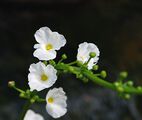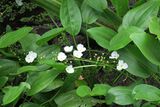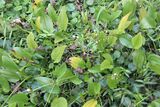Aquarius palifolius (Nees & Mart.) Christenh. & Byng

Basionym : Echinodorus palifolius (Nees & Mart.) J.F.Macbr.[1]
Synonyms :
Alisma ellipticum Mart. ex Schult.f.
Alisma ellipticum var. minus Seub.
Alisma nathpurense Steud.
Alisma palifolium (Nees & Mart.) Kunth
Alisma virgata Hook. & Arn.
Echinodorus ellipticus (Mart. ex Schult.f.) Micheli
Echinodorus ellipticus var. latifolius Micheli
Echinodorus palifolius var. latifolius (Micheli) Rataj
Echinodorus palifolius var. minus (Seub.) Rataj
Echinodorus virgatus (Hook. & Arn.) Micheli
Sagittaria palifolia Nees & Mart.
Sagittaria palifolia var. elliptica (Mart. ex Schult.f.) Kuntze
Sagittaria palifolia f. foliosobracteata Kuntze
Sagittaria palifolia var. heterophylla Kuntze
Sagittaria palifolia var. undulata Kuntze
Occurrence:
Eastern Brazil.
Ecology
At altitudes of 200 - 800 m.
Morphology General habit
Perennial, from rhizomes, petioles and stems glabrous to pubescent, up to 110 cm
Morphology Leaves
Leaves emersed, blade lanceolate to elliptic, 7 - 11-veined, 8 - 25 cm long, 5.5 - 20 cm wide, translucent markings absent or present as lines, apex round, base truncate to cordate, petioles canaliculate, corrugated, up to 20 - 47 cm long, 5 - 20 mm in diameter, base with sheath up to 7 cm long
Morphology Reproductive morphology Fruits
Fruit oblanceoloid, 5 - 6-ribbed, glandular, 1.8 - 2.5 mm long, 1 mm wide, glands 1 - 3, circular, separated by ribs, beak end, erect, 0.4 - 1 mm.
Morphology Reproductive morphology Inflorescences
Inflorescence racemose or paniculate, of 8 - 18 whorls, each 7 - 25-flowered, erect, leaves overlapping, non-propagating, 30 - 60 cm long, up to 15 cm wide, rachis triangular in cross-section, broadly cleft, pedicels furrowed, up to 50 cm long, c. 12 mm diam, bracts slightly fused at the base, lanceolate, longer than the stems, up to 1.5 - 3.5 cm long, approx. 12 mm in diameter, 6 mm wide, 12 - 17-veined, long pointed tip, pedicels spread out in flower and fruit, 0.1 - 1.5 cm long, approx. 0.5 mm in diameter, flowers c. 2 cm in diameter, sepals and petals spreading, sepals 10 - 13-veined, c. 5 mm long, c. 4 mm wide, veins without papillae, petals not clawed, not overlapping, c. 12 mm long, c. 10 mm wide, stamens 12, anthers many, c. 1.5 mm long, filaments c. 1.5 mm long, carpels numerous
Note
Echinodorus virgatus was probably described from a single collection from Tepic in the state of Nayarit, Mexico (Hooker & Arnott 1838). There are no later collections and the taxon is considered extinct (Lot et al. 1999). According to Haynes & Holm-Nielsen (1994), this taxon differs from the other species, especially from other Mexican species. The distinguishing features are translucent lines, winged rachis and round glands in the fruits (Haynes & Holm-Nielsen 1994). These features are typical of E. palaefolius, and phylogenetic analysis has identified E. virgatus as sister with few morphological differences in consecutive characters (Lehtonen & Myllys 2008).
Phenology
Flowering and fruiting from January to June. [1]
-
,Aquarius palifolius (Nees & Mart.) Christenh. & Byng[2]
-
,Aquarius palifolius (Nees & Mart.) Christenh. & Byng[3]
-
,Aquarius palifolius (Nees & Mart.) Christenh. & Byng [4]
-
,Aquarius palifolius (Nees & Mart.) Christenh. & Byng [4]
-
,Aquarius palifolius (Nees & Mart.) Christenh. & Byng [4]
-
,Aquarius palifolius (Nees & Mart.) Christenh. & Byng [4]
-
,Aquarius palifolius (Nees & Mart.) Christenh. & Byng [4]
- ↑ 1.0 1.1 POWO (2021). "Plants of the World Online. Facilitated by the Royal Botanic Gardens, Kew. Im Internet veröffentlicht; http://www.plantsoftheworldonline.org/ Abgerufen am 22. August 2021."
- ↑ "Echinodorus palaefolius [Mexican Sword-Plant] Alismataceae" by tuis is licensed under CC BY-NC-ND 2.0
- ↑ "Echinodorus palaefolius" by Dinesh Valke is licensed under CC BY-SA 2.0
- ↑ 4.0 4.1 4.2 4.3 4.4 by syasyaridzuan (licensed under http://creativecommons.org/licenses/by-nc/4.0/







